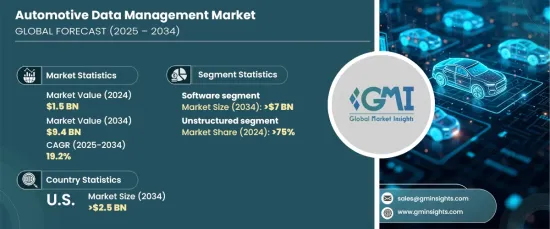
세계의 자동차 데이터 관리 시장은 2024년에 15억 달러가 되었고, 2025년부터 2034년까지의 CAGR은 19.2%로 예측되어 현저한 성장을 이루려고 하고 있습니다.
이 급성장의 배경은 커넥티드카와 사물인터넷(IoT)의 급속한 통합입니다. 자동차 제조업체는 개인화된 운전 경험, 실시간 차량 성능에 대한 통찰력, 안전 대책 강화에 대한 소비자 수요 증가에 대응하기 위해 고급 데이터 관리 시스템의 채택을 늘리고 있습니다. 이러한 진보는 지능적이고 연결된 자동차 생태계로의 업계 전반적인 변화를 반영합니다.

텔레매틱스와 차량 관리 기술의 도입은 시장의 성장 궤도를 더욱 가속화하고 있습니다. 이러한 시스템은 차량의 건강 상태를 실시간으로 모니터링하고, 물류 업무를 최적화하고, 안전 프로토콜을 강화함으로써 전반적인 효율성을 높이면서 운영 비용을 대폭 절감합니다. 라이드 헤일링과 카셰어링 플랫폼을 포함한 공유 모빌리티 서비스의 보급도 시장 확대의 주요 요인으로 떠오르고 있습니다. 이러한 서비스는 엄청난 데이터 스트림을 생성하므로 견고한 관리 솔루션이 필요하며 원활한 운영과 사용자 만족도를 보장합니다.
| 시장 범위 | |
|---|---|
| 시작 연도 | 2024년 |
| 예측 연도 | 2025-2034년 |
| 시작 금액 | 15억 달러 |
| 예측 금액 | 94억 달러 |
| CAGR | 19.2% |
시장은 소프트웨어 및 서비스로 나뉘어 2024년 점유율은 소프트웨어가 75%를 차지했습니다. 이 부문은 커넥티드카로부터 출력되는 방대한 데이터를 처리하는데 중요한 역할을 하기 때문에 2034년까지 70억 달러를 창출할 것으로 예측되고 있습니다. 자동차 소프트웨어 솔루션은 실시간 분석, 예지 보전, 간소화된 차량 관리를 용이하게 합니다. 그 확장성을 통해 기업은 끊임없이 복잡해지는 자동차 산업 상황을 극복할 수 있으며, 소프트웨어는 업계에 필수적인 요소가 되었습니다.
데이터 유형에 따라 시장은 구조화된 데이터, 반구조화된 데이터, 비구조화된 데이터로 분류됩니다. 2024년에는 비구조화 데이터가 75%의 점유율을 차지하여 시장을 선도했습니다. 이 카테고리에는 센서 데이터, 운전자 행동 분석, 자동차 시스템의 멀티미디어 컨텐츠 등 다양한 귀중한 정보가 포함됩니다. 비구조화된 데이터를 활용함으로써 자동차 제조업체는 실용적인 통찰력을 도출하고 차량 성능, 안전 기능 및 전반적인 사용자 경험을 향상시킬 수 있으며 현대 데이터 관리 전략이 필요합니다.
미국의 자동차 데이터 관리 시장은 2024년 세계 점유율의 75%를 차지했으며, 2034년에는 25억 달러에 이를 것으로 예측됩니다. 견고한 자동차 제조거점과 첨단 데이터 인프라에 뒷받침된 커넥티드 차량 혁신의 이 나라의 리더십이 이 성장을 뒷받침하고 있습니다. 데이터 수집 및 분석 생태계가 확립된 미국은 실시간 분석과 차량 인텔리전스의 획기적인 진보를 지속적으로 이끌어 자동차 데이터 관리의 세계 리더 역할을 확고히 하고 있습니다.
The Global Automotive Data Management Market, valued at USD 1.5 billion in 2024, is poised for remarkable growth with a projected CAGR of 19.2% from 2025 to 2034. This surge is fueled by the rapid integration of connected vehicles and the Internet of Things (IoT), which collectively generate massive data volumes requiring efficient storage, processing, and analysis solutions. Automakers are increasingly adopting advanced data management systems to meet rising consumer demands for personalized driving experiences, real-time vehicle performance insights, and enhanced safety measures. These advancements reflect a broader industry shift toward intelligent and connected automotive ecosystems.

The deployment of telematics and fleet management technologies has further amplified the market's growth trajectory. These systems empower real-time vehicle health monitoring, optimize logistics operations, and bolster safety protocols, significantly reducing operational costs while enhancing overall efficiency. The proliferation of shared mobility services, including ride-hailing and car-sharing platforms, has also emerged as a key contributor to the market's expansion. These services produce extensive data streams that demand robust management solutions, ensuring seamless operations and user satisfaction.
| Market Scope | |
|---|---|
| Start Year | 2024 |
| Forecast Year | 2025-2034 |
| Start Value | $1.5 Billion |
| Forecast Value | $9.4 Billion |
| CAGR | 19.2% |
The market is divided into software and services, with software commanding a dominant 75% share in 2024. This segment is forecasted to generate USD 7 billion by 2034, driven by its critical role in processing the immense data output of connected vehicles. Automotive software solutions facilitate real-time analytics, predictive maintenance, and streamlined fleet management. Their scalability enables businesses to navigate the ever-evolving complexities of the automotive landscape, positioning software as an indispensable element of the industry.
On the basis of data type, the market is categorized into structured, semi-structured, and unstructured data. In 2024, unstructured data led the market with a commanding 75% share. This category includes diverse and valuable information such as sensor data, driver behavior analytics, and multimedia content from in-vehicle systems. By leveraging unstructured data, automakers can derive actionable insights to enhance vehicle performance, safety features, and overall user experiences, making it a cornerstone of contemporary data management strategies.
The U.S. automotive data management market accounted for 75% of the global share in 2024 and is projected to reach USD 2.5 billion by 2034. The country's leadership in connected vehicle innovations, underpinned by a robust automotive manufacturing base and advanced data infrastructure, drives this growth. With an established ecosystem for data collection and analysis, the U.S. continues to spearhead breakthroughs in real-time analytics and vehicle intelligence, solidifying its role as a global leader in automotive data management.